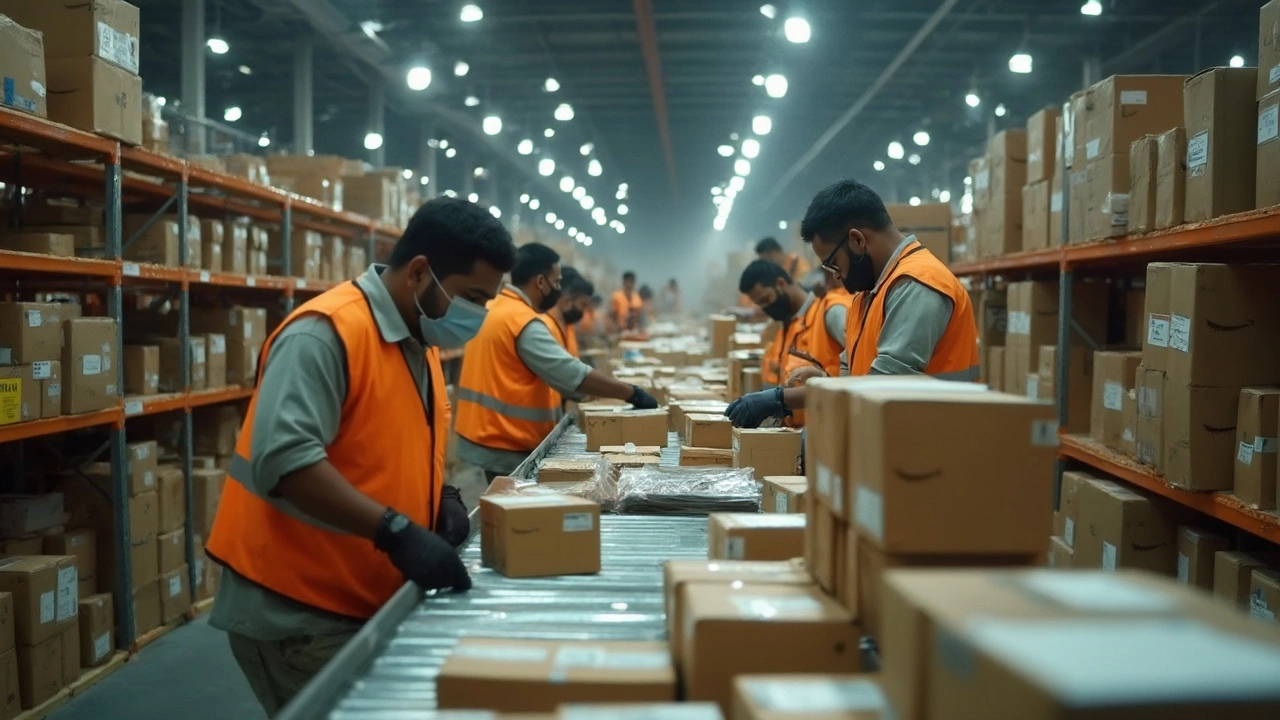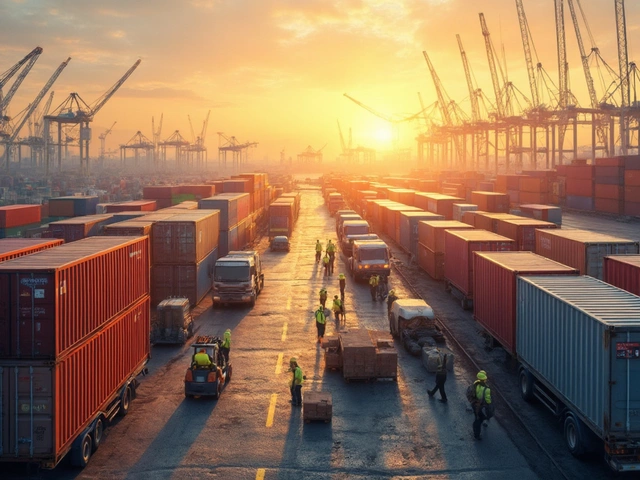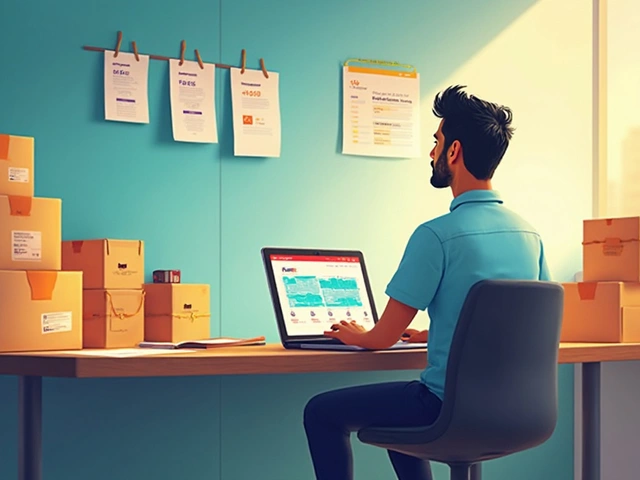Amazon didn’t just change the way we shop—it built the playbook for modern e-commerce logistics. Few companies can deliver a phone charger overnight or groceries the same day with such consistency. No wonder it’s the platform everyone thinks of first when e-commerce comes up.
Ever notice those smiley Amazon packages on your doorstep almost daily? That’s no accident. Amazon invested billions into warehouses, speedy delivery vans, robot helpers, and even its own cargo planes so you can order anything from fish food to laptops and have them at your door in record time. Last Prime Day, Amazon shipped over 375 million items worldwide—just in a couple of days. That kind of scale makes logistics look easy, but behind the scenes, it’s a massive coordination game.
If you’re thinking about selling online or already run an e-commerce store, there’s a lot to learn from how Amazon does it. Fast shipping, clear inventory tracking, and having goods stored close to customers are just basics for them, not the finish line. We’ll dig into what makes Amazon’s system run so smooth and offer hands-on tips for anyone who wants to up their own logistics game.
- Amazon and Its Unbeatable Popularity
- How Amazon Changed E-Commerce Logistics
- What Makes Amazon’s Supply Chain Tick
- Tips for Sellers to Leverage Amazon’s System
- The Impact on Shopping and Business Trends
Amazon and Its Unbeatable Popularity
When most folks think about online shopping, Amazon is the first name that pops up. There’s a good reason: it’s the biggest e-commerce player in the world. Back in 2024, Amazon raked in over $570 billion in net sales, which is way ahead of any competitor. The platform isn’t just about size—it's about speed, choice, and how easy it is to use. With millions of products and quick delivery, it’s basically become the go-to place for shopping online.
Here’s something wild: about 200 million people globally have Amazon Prime memberships. That’s like the entire population of Brazil signed up for fast shipping and streaming perks. In the United States, more than half of all online shoppers start their product searches on Amazon, not Google. This grip on shoppers has made it almost impossible for other retailers to match Amazon’s reach and loyalty.
The most important thing setting Amazon apart is its focus on logistics. It’s not just a website. Behind those neat product listings, there’s a huge network of warehouses, robots, and delivery drivers who work around the clock. No wonder that Amazon handles anywhere from 1.6 to 2.0 million packages per day in the US alone.
Check out these jaw-dropping stats about Amazon’s popularity:
| Fact | Number |
|---|---|
| Amazon Prime Members (Worldwide) | 200 million+ |
| Net Sales (2024) | $570+ billion |
| Daily US Packages Shipped | 1.6–2.0 million |
| Global Marketplace Sellers | ~9.7 million |
If you’re shopping for electronics, books, clothes, or even groceries, chances are Amazon’s got what you need. Its marketplace is so trusted that even big brands sell directly through Amazon because that’s where the buyers are. For most people, Amazon is the gold standard—not just for selection, but for convenience and reliability. That’s what keeps pulling shoppers back again and again.
How Amazon Changed E-Commerce Logistics
Most people don’t realize just how much Amazon has reinvented the way products move from warehouses to your front porch. This didn’t happen overnight. Early on, Amazon started building fulfillment centers in key spots across the world so their stuff was always closer to customers. By 2023, Amazon had more than 175 massive fulfillment centers globally.
They leaned into tech big time, packing warehouses with robots that run miles every day, grabbing products and bringing them to workers who pack the boxes. This kind of automation cuts down error and speeds things up, which means faster delivery for everyone.
Probably the flashiest move was their creation of Amazon Prime. The promise? Two-day shipping (or even less), which used to sound impossible. To pull this off, Amazon built its own delivery network—think a mix between FedEx and Uber. They use planes, trucks, even electric vans, and a gig-style service called Amazon Flex.
Here’s a peek at how deep they go with logistics:
- Over 110 planes in their Amazon Air fleet as of 2024, making almost 200 flights a day in the U.S. alone
- Around 1,000 distribution centers of all sizes worldwide
- Partners with more than 2,500 delivery service businesses and over 150,000 drivers
Even their supply chain software reads like something out of a sci-fi movie—it predicts what people will buy before they click “order,” getting products shipped close to buyers ahead of time. It’s called "anticipatory shipping," and it helps beat that “out of stock” problem.
Take a look at some eye-opening numbers:
| Amazon Fact | Number (2024) |
|---|---|
| Active warehouses globally | Over 175 |
| Amazon Air daily flights (U.S.) | Nearly 200 |
| Prime members worldwide | Over 230 million |
Why does all this matter? Because when Amazon moves faster and smarter, everyone else in e-commerce scrambles to keep up. Free shipping speeds, real-time tracking, and fast returns have become the new normal because Amazon made them standard. Businesses now have to up their game just to stay in the race.

What Makes Amazon’s Supply Chain Tick
Amazon’s supply chain is all about speed, scale, and constant improvement. The company runs more than 1,100 fulfillment centers globally, each loaded with robots and tech that sort, pick, and prep packages at breakneck speeds. Inventory is tracked in real-time, so when you hit “buy,” the system kicks in instantly, finding the closest warehouse that has your item and mapping the fastest way to get it to your door.
Automation is at the heart of the process. Amazon uses around 750,000 robots—mostly little orange pods called Kiva robots—that zip around huge warehouses, grabbing shelves and bringing them right to workers. This means no one is running around looking for your blender: the robot delivers the shelf straight to them. This tech cuts down on picking times and keeps errors to a minimum.
But robots aren’t the only story. Amazon flexes its own delivery network called Amazon Logistics, with tens of thousands of Amazon-branded vans and a growing air fleet (over 100 Prime Air planes as of last year). This direct control lets Amazon offer One-Day and even Same-Day shipping to most big cities. The company isn’t shy about making new moves either—they’re experimenting with delivery drones in the US and UK, so the speed could jump even more soon.
Amazon also uses a predictive system called "anticipatory shipping." Basically, they stock up on items they think you’ll want, even before you click the order button. An engineer summed it up in Wired by saying,
"We’re betting data can get packages moving before the customer even decides.”That level of prediction is why popular products seem to arrive almost before you need them.
For sellers, Amazon’s Fulfillment by Amazon (FBA) program is a game-changer. You ship your stuff to their warehouse, and Amazon handles everything—packing, shipping, returns. Small businesses get access to the same fast shipping that helps big brands win, and buyers trust products that use FBA.
When people talk about the gold standard for Amazon logistics, they’re talking about this: robots working with humans, delivery vans and planes everywhere, a global network of warehouses, and smart prediction software. It’s a supply chain that never stops upgrading.
Tips for Sellers to Leverage Amazon’s System
Trying to stand out on Amazon isn’t about luck—it’s about knowing how the system works and playing it smart. Whether you’re new or already selling, you can tap into Amazon’s massive audience and logistics muscle to grow fast. Here’s how to actually do it.
First off, Fulfillment by Amazon (FBA) is a game-changer. FBA lets Amazon handle storage, packing, and shipping for you. You send your products to their warehouses, and they take care of the rest—including customer returns. What makes FBA so handy is that products using it get the Prime badge, which shoppers trust. About 86% of the top Amazon sellers use FBA—that’s not a small number.
- Keep inventory levels up. If your item is out of stock, it drops in rankings. That means fewer eyes (and wallets) on your product.
- Use Amazon’s tools. Their pricing and advertising tools can help boost visibility. Sponsored Products isn’t just for the big brands.
- Watch your reviews and respond to customer questions. Fast replies and good feedback matter for ranking and winning the 'Buy Box'.
- Optimize your listings: Simple language, sharp photos, and clear descriptions get clicks.
One big advantage of Amazon is how fast and reliably they deliver. That’s a selling point for you too. Buyers expect two-day shipping, and FBA makes that possible without you lifting a finger.
| Amazon Seller Stat | Value (2024) |
|---|---|
| Total Active Sellers Worldwide | 6.3 million |
| Sellers Using FBA | 86% |
| Prime-eligible products | Over 200 million |
| Avg. customer review response time (top sellers) | 24 hours |
Don’t ignore logistics details. Always package items well and check that your product actually qualifies for FBA. Little slip-ups—like labeling errors or late shipments—can get you banned from using their services. Also, track your inventory turnover rate with Amazon’s dashboard and try to keep your restocking lead time short. If you let Amazon run out of your stuff, you lose sales and even rankings.
One last thing: test different prices and try ads, but don’t go crazy with discounts. Keep an eye on what your competition’s doing. Use the data Amazon gives you to stay on top, not just in the game. Master these moves, and you’ll get the most out of the Amazon machine.

The Impact on Shopping and Business Trends
The rise of Amazon totally changed what people expect from online shopping. Fast, cheap shipping used to be a bonus—now, it’s something shoppers count on. If your site can’t match that, a lot of people will go somewhere else. Amazon’s two-day Prime shipping made shipping speeds a deal breaker for millions.
Online shoppers are also getting pickier. They want clear package tracking, hassle-free returns, and loads of product reviews. Sellers on Amazon are pushed to meet these high expectations, making the whole e-commerce market sharper. Even smaller brands feel the pressure—they either jump on Amazon or work extra hard to match its service outside the platform.
When it comes to Amazon itself, the impact doesn’t stop with retail. Their logistics arm, Amazon Logistics, has rolled out thousands of delivery vans, huge fulfillment centers, and even air cargo services. This massive investment not only makes shopping easier but has set a new bar for the industry.
- Nearly 60% of US online shoppers start product searches on Amazon, not Google
- Over 2 million small and medium-sized businesses sell through Amazon’s marketplace
- More than half of Amazon’s yearly sales now come from third-party sellers
Take a look at real numbers showing Amazon’s weight in e-commerce:
| Metric | Amazon (2024) |
|---|---|
| US E-commerce Market Share | ~37% |
| Prime Members Worldwide | Over 230 million |
| Annual Revenue | $574.8 billion |
| Countries with Dedicated Marketplaces | 20+ |
This kind of dominance means even giant brands have to rethink their strategies. You see more companies offering same-day delivery, beefing up returns, and copying Amazon’s “customers first” policies. It’s not just about the products anymore—it’s all about experience.
If you run an e-commerce business, watching what Amazon does isn’t optional. Use their customer service playbook: make shipping faster, show tons of reviews, and make returns painless. Customers now expect all that, no matter where they shop online.





